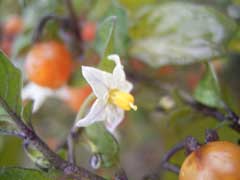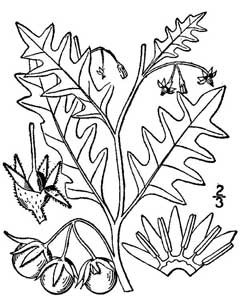 |
|
http://commons.wikimedia.org/wiki/User:TeunSpaans |
 |
| USDA-NRCS PLANTS Database / Britton, N.L., and A. Brown. 1913. An illustrated flora of the northern United States, Canada and the British Possessions. 3 vols. Charles Scribner's Sons, New York. Vol. 3 |
Translate this page:
Summary
Physical Characteristics

 Solanum triflorum is a ANNUAL growing to 0.8 m (2ft 7in). The species is hermaphrodite (has both male and female organs) and is pollinated by Insects.
Solanum triflorum is a ANNUAL growing to 0.8 m (2ft 7in). The species is hermaphrodite (has both male and female organs) and is pollinated by Insects.
Suitable for: light (sandy), medium (loamy) and heavy (clay) soils and prefers well-drained soil. Suitable pH: mildly acid, neutral and basic (mildly alkaline) soils. It cannot grow in the shade. It prefers dry or moist soil.
UK Hardiness Map
US Hardiness Map
Synonyms
Plant Habitats
Cultivated Beds;
Edible Uses
Edible Parts: Fruit
Edible Uses:
Fruit - raw or cooked[46, 105, 161]. Used in times of food shortage[257]. Eaten as a fruit or vegetable, the fruit can also be dried, ground into a powder and used with cereals for making bread etc[61]. The ripe fruit can be boiled, mashed and mixed with ground chilli and salt then used as a condiment with mush or bread[257].
References More on Edible Uses
Medicinal Uses
Plants For A Future can not take any responsibility for any adverse effects from the use of plants. Always seek advice from a professional before using a plant medicinally.
Astringent Stomachic
A decoction of the berries has been used in the treatment of stomach aches and for children with diarrhoea[257].
References More on Medicinal Uses
The Bookshop: Edible Plant Books
Our Latest books on Perennial Plants For Food Forests and Permaculture Gardens in paperback or digital formats.

Edible Tropical Plants
Food Forest Plants for Hotter Conditions: 250+ Plants For Tropical Food Forests & Permaculture Gardens.
More

Edible Temperate Plants
Plants for Your Food Forest: 500 Plants for Temperate Food Forests & Permaculture Gardens.
More

More Books
PFAF have eight books available in paperback and digital formats. Browse the shop for more information.
Shop Now
Other Uses
References More on Other Uses
Cultivation details
Succeeds in most soils in a sunny position[1]. This species is said to be a good companion for watermelons, it has been planted with them in order to make the watermelons more prolific and ripen earlier[257]. An infusion of the plant has been sprayed on the watermelons in order to make them more prolific and ripen earlier[257].
References Carbon Farming Information and Carbon Sequestration Information
Temperature Converter
Type a value in the Celsius field to convert the value to Fahrenheit:
Fahrenheit:
The PFAF Bookshop
Plants For A Future have a number of books available in paperback and digital form. Book titles include Edible Plants, Edible Perennials, Edible Trees,Edible Shrubs, Woodland Gardening, and Temperate Food Forest Plants. Our new book is Food Forest Plants For Hotter Conditions (Tropical and Sub-Tropical).
Shop Now
Plant Propagation
Seed - sow spring in a greenhouse. When they are large enough to handle, prick the seedlings out into individual pots and plant them out after the last expected frosts.
Other Names
If available other names are mentioned here
Native Range
NORTHERN AMERICA: Canada (Saskatchewan, Alberta, Manitoba, British Columbia), United States (Massachusetts, Michigan, Ohio, Illinois, Iowa, Kansas, Minnesota (west), Missouri, Nebraska, North Dakota, Oklahoma, South Dakota, Wisconsin, Colorado, Idaho, Montana, Oregon, Washington, Wyoming, Arkansas, New Mexico, Texas, Arizona, California, Nevada, Utah) SOUTHERN AMERICA: Argentina (Buenos Aires, Chubut, Córdoba, La Pampa, La Rioja, Mendoza, Neuquén, Río Negro, Salta, San Juan, San Luis, Santa Cruz, Santa Fe, Tucumán)
Weed Potential
Right plant wrong place. We are currently updating this section.
Please note that a plant may be invasive in one area but may not in your area so it's worth checking.
Conservation Status
IUCN Red List of Threatened Plants Status :

| Related Plants
|
| Latin Name | Common Name | Habit | Height | Hardiness | Growth | Soil | Shade | Moisture | Edible | Medicinal | Other |
| Solanum aethiopicum | Mock Tomato, Ethiopian nightshade | Shrub | 2.5 |
10-12
| | LMH | N | M | 3 | 2 | 2 |
| Solanum ajanhuiri | Ajanhuiri | Perennial | 0.0 |
9-11
| | LMH | SN | M | 2 | 0 | |
| Solanum americanum | American Nightshade, American black nightshade | Annual | 1.0 |
0-0
| | LMH | N | M | 1 | 0 | 0 |
| Solanum andigenum | Andigena | Perennial | 0.0 |
-
| | LMH | N | M | 2 | 0 | |
| Solanum aviculare | Kangaroo Apple, New Zealand nightshade | Shrub | 1.8 |
8-11
| | LMH | N | M | 2 | 2 | 2 |
| Solanum boreale | | Perennial | 0.0 |
-
| | LMH | N | M | 1 | 0 | |
| Solanum boyacense | | Perennial | 0.0 |
-
| | LMH | N | M | 1 | 0 | |
| Solanum cari | | Perennial | 0.0 |
-
| | LMH | SN | M | 1 | 0 | |
| Solanum carolinense | Horse Nettle, Carolina horsenettle | Perennial | 1.0 |
3-7
| | LMH | SN | M | 0 | 2 | 1 |
| Solanum chaucha | Chaucha | Perennial | 0.0 |
-
| | LMH | SN | M | 1 | 0 | |
| Solanum curtilobum | Rucki | Perennial | 0.0 |
-
| | LMH | SN | M | 2 | 0 | |
| Solanum dulcamara | Bittersweet. Bittersweet Nightshade, Climbing nightshade, Bittersweet, Deadly Nightshade, Poisonous | Perennial Climber | 2.5 |
4-8
| M | LMH | SN | M | 0 | 3 | 0 |
| Solanum fendleri | Wild Potato, Fendler's horsenettle, Texan horsenettle | Perennial | 0.0 |
0-0
| | LMH | N | M | 3 | 2 | |
| Solanum jamesii | Colorado Wild Potato, Wild potato | Perennial | 0.2 |
8-11
| | LMH | N | M | 2 | 0 | |
| Solanum juzepczukii | Rucki | Perennial | 0.0 |
-
| | LMH | SN | M | 2 | 0 | |
| Solanum kurzii | | Perennial | 0.0 |
-
| | LMH | SN | M | 1 | 0 | |
| Solanum laciniatum | Kangaroo Apple | Shrub | 3.0 |
8-11
| | LMH | N | M | 2 | 2 | 2 |
| Solanum linearifolium | Mountain Kangaroo Apple | Shrub | 0.0 |
-
| | LMH | N | M | 2 | 0 | |
| Solanum liximitante | | Perennial | 0.0 |
-
| | LMH | SN | M | 1 | 0 | |
| Solanum luteum | | Annual | 0.0 |
-
| | LMH | SN | M | 1 | 0 | |
| Solanum lycopersicum | Tomato, Garden Tomato | Annual | 2.0 |
10-12
| F | LMH | N | M | 5 | 3 | 3 |
| Solanum lyratum | | Perennial Climber | 2.0 |
-
| | LMH | N | M | 1 | 2 | |
| Solanum maglia | | Perennial | 0.0 |
-
| | LMH | N | M | 2 | 0 | |
| Solanum melongena | Aubergine, Eggplant | Perennial | 1.0 |
8-11
| | LMH | N | M | 3 | 2 | |
| Solanum muricatum | Pepino | Shrub | 1.0 |
8-11
| | LMH | N | M | 4 | 0 | 0 |
| Solanum nigrum | Black Nightshade, Common Nightshade, Poisonberry, Black Nightshade | Annual | 0.6 |
0-0
| | LMH | N | DM | 2 | 2 | 2 |
| Solanum paniculatum | Jurubeba, Nightshade | Shrub | 2.0 |
10-12
| F | LMH | SN | M | 0 | 4 | 0 |
| Solanum phureja | Phureja, Nightshade | Perennial | 0.0 |
8-11
| | LMH | SN | M | 3 | 0 | |
| Solanum piliferum | | Perennial | 0.0 |
-
| | LMH | N | M | 2 | 0 | |
| Solanum pimpinellifolium | Currant Tomato | Annual/Biennial | 1.0 |
10-12
| F | LMH | N | M | 4 | 2 | 2 |
|
|
Growth: S = slow M = medium F = fast. Soil: L = light (sandy) M = medium H = heavy (clay). pH: A = acid N = neutral B = basic (alkaline). Shade: F = full shade S = semi-shade N = no shade. Moisture: D = dry M = Moist We = wet Wa = water.
Now available:
Food Forest Plants for Mediterranean Conditions
350+ Perennial Plants For Mediterranean and Drier Food Forests and Permaculture Gardens.
[Paperback and eBook]
This is the third in Plants For A Future's series of plant guides for food forests tailored to
specific climate zones. Following volumes on temperate and tropical ecosystems, this book focuses
on species suited to Mediterranean conditions—regions with hot, dry summers and cool, wet winters,
often facing the added challenge of climate change.
Read More
Expert comment
Author
Nutt.
Botanical References
43235
Links / References
For a list of references used on this page please go here
Readers comment
© 2010, Plants For A Future. Plants For A Future is a charitable company limited by guarantee, registered in England and Wales. Charity No. 1057719, Company No. 3204567.